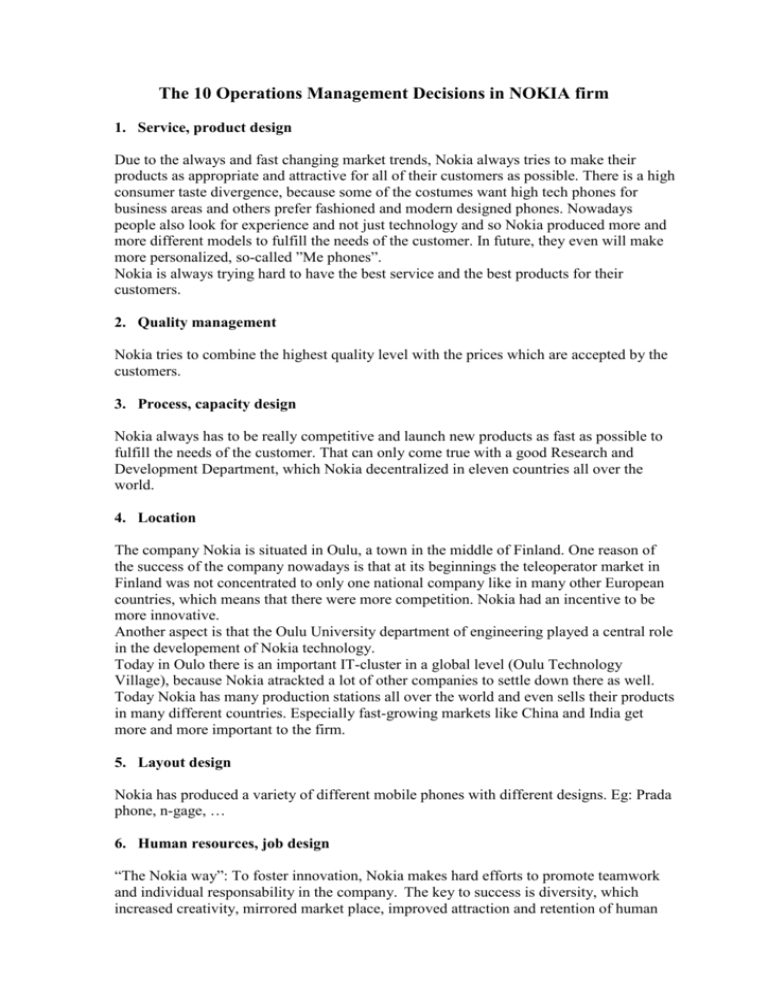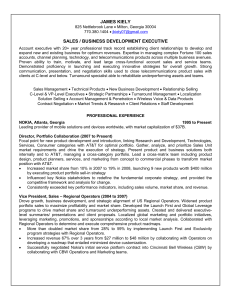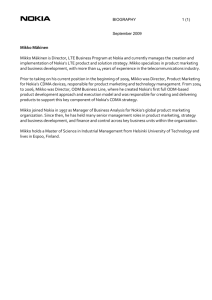The 10 Operations Management Decisions in NOKIA firm
advertisement

The 10 Operations Management Decisions in NOKIA firm 1. Service, product design Due to the always and fast changing market trends, Nokia always tries to make their products as appropriate and attractive for all of their customers as possible. There is a high consumer taste divergence, because some of the costumes want high tech phones for business areas and others prefer fashioned and modern designed phones. Nowadays people also look for experience and not just technology and so Nokia produced more and more different models to fulfill the needs of the customer. In future, they even will make more personalized, so-called ”Me phones”. Nokia is always trying hard to have the best service and the best products for their customers. 2. Quality management Nokia tries to combine the highest quality level with the prices which are accepted by the customers. 3. Process, capacity design Nokia always has to be really competitive and launch new products as fast as possible to fulfill the needs of the customer. That can only come true with a good Research and Development Department, which Nokia decentralized in eleven countries all over the world. 4. Location The company Nokia is situated in Oulu, a town in the middle of Finland. One reason of the success of the company nowadays is that at its beginnings the teleoperator market in Finland was not concentrated to only one national company like in many other European countries, which means that there were more competition. Nokia had an incentive to be more innovative. Another aspect is that the Oulu University department of engineering played a central role in the developement of Nokia technology. Today in Oulo there is an important IT-cluster in a global level (Oulu Technology Village), because Nokia atrackted a lot of other companies to settle down there as well. Today Nokia has many production stations all over the world and even sells their products in many different countries. Especially fast-growing markets like China and India get more and more important to the firm. 5. Layout design Nokia has produced a variety of different mobile phones with different designs. Eg: Prada phone, n-gage, … 6. Human resources, job design “The Nokia way”: To foster innovation, Nokia makes hard efforts to promote teamwork and individual responsability in the company. The key to success is diversity, which increased creativity, mirrored market place, improved attraction and retention of human resources. Nokia is a melting pot of people and gives the employees a change to work at an international level. When employees in the company are satisfied, they make ”good products” and thus also costumers will get satisfied. The keywords considering that are trust, cooperation, sharing, openness, networking, humanity, respect, customer friendliness and so on. Nokia’s secret are flat team organisations and working with cross-functional teams, which is a group of employees from various functional areas of the organization – research, engineering, marketing, finance. human resources, and operations, for example – who are all focused on a specific objective and are responsible to work as a team to improve coordination and innovation across divisions and resolve mutual problems. One example for that is Nokia India, where Nokia HR department closely tracks every employee's progress. Every September, Nokia employees across mobile phones, networks and two R&D divisions set up teams comprising 6-8 employees. Each of these crossfunctional teams has employees from marketing, sales and logistics, who would already have submitted a performance rating of themselves, the company, the division and so on, on various parameters. The teams are told to formulate an action plan and improve on the parameters with the lowest scores. The HR department coordinates this exercise and reviews progress every quarter. All in all, Nokia has strong networks with suppliers and research institutes and very often teams are multinational and operate mainly virtually. It is clear that the teams and their new product development projects contribute a lot to the success of the product, thus they are really important to the firm. 7. Supply-chain management Nokia gives a lot of attention to logistics optimation like production costs and flexible manufacturing. The company is strong in low cost models as well as high end products. The plants are in Brazil, China, Finland, India, Germany, Hungary, Mexico, the Republic of Korea and UK. A new plant will be opened in Romania. Nokia maintains a flexible global manufacturing network and quickly responses to the demands of a good logisticsystem: • No inventories (moved to suppliers) • Highly automatized production • Focus on ITC systems and production platform flexibility • Stong supplier relationships (eg phone cover manufacturer deliveres just on 4 hour notice) – high trust 8. Inventory management The comprehensive and powerful inventory management engine from Nokia Siemens Networks automates standard processes such as planning, fault resolution, customer care, provisioning and network management. It increases customer satisfaction and delivers quicker return on investment by reducing deployment risk and roll-out time. 9. Scheduling Due to the fact that customer tastes wary and change quicky, the product life cycles are getting shorter and shorter. Nokia has to be sure that it can segure product extensions and quick response to the needs of the target market. 10. Maintenance To stay alive and maintain the success of the company, Nokia considers the client and fast reactions to the speed of the changing market as the keys. Nowadays they focus on Asia and BRIC-countries (Brasil, Russia, China and India getting stronger), because there is a great potential market. Even if Nokia is the market leader, it should not stop thinking in improving their products and services. They also put attention to new technologies and set standards deeper to Internet and wireless innovations. New partners like Siemens are also really important for the firm and especially concerning smart phones competition will become even harder (eg. RIM, Apple, Windows based smartphones…).




